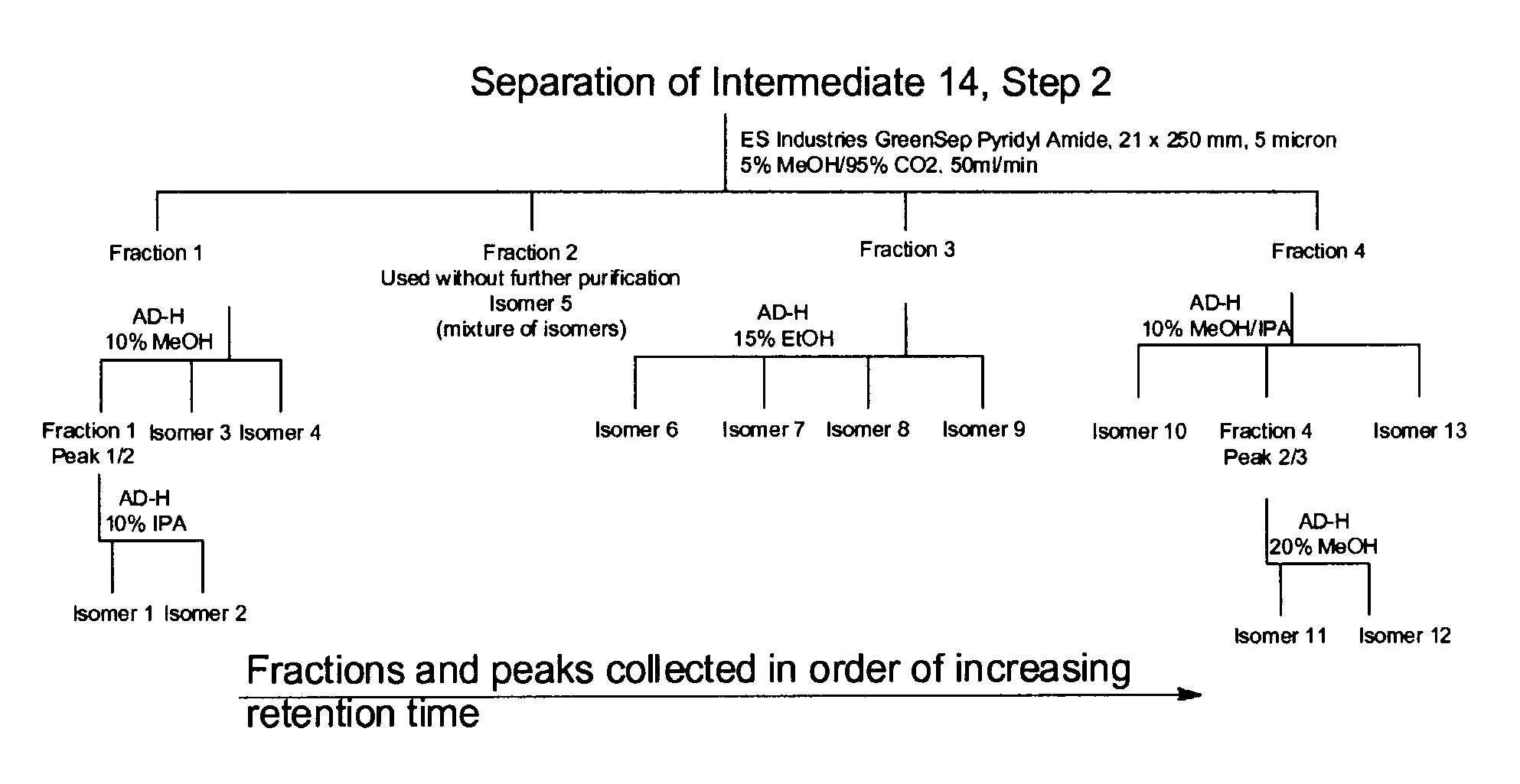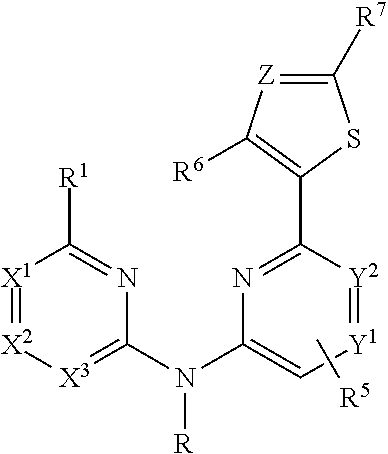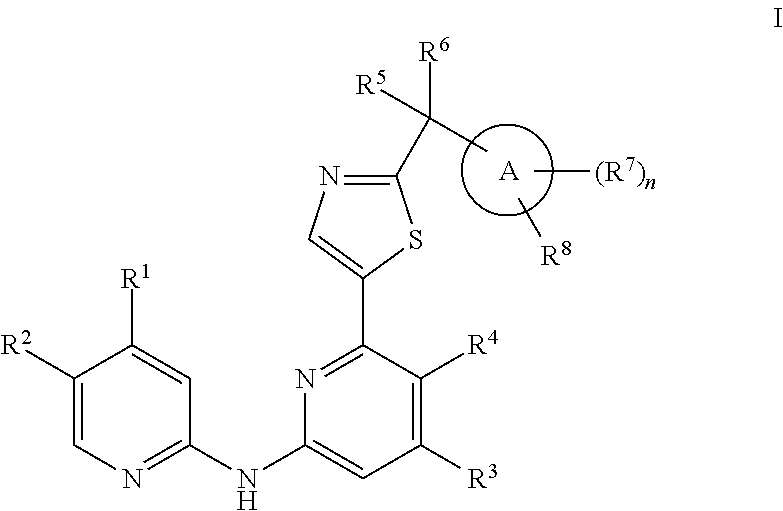Pyridyl aminopyridines as Syk inhibitors
a technology of pyridyl aminopyridine and syk inhibitor, which is applied in the direction of drug composition, immunological disorders, organic chemistry, etc., can solve the problems of reducing rheumatoid factor production and cell function
- Summary
- Abstract
- Description
- Claims
- Application Information
AI Technical Summary
Benefits of technology
Problems solved by technology
Method used
Image
Examples
example 1
racemic trans-4-[1-(5-{6-[(4-Cyclopropylpyridin-2-yl)amino]-4-methylpyridin-2-yl}-1,3-thiazol-2-yl)-1-hydroxypropyl]cyclohexanecarboxylic acid, trans-4-[(1R)-1-(5-{6-[(4-cyclopropylpyridin-2-yl)amino]-4-methylpyridin-2-yl}-1,3-thiazol-2-yl)-1-hydroxypropyl]cyclohexanecarboxylic acid, and trans-4-[(1S)-1-(5-{6-[(4-cyclopropylpyridin-2-yl)amino]-4-methylpyridin-2-yl}-1,3-thiazol-2-yl)-1-hydroxypropyl]cyclohexanecarboxylic acid
[0283]
[0284]Step 1:
[0285]A dry round bottom flask was charged with trans-4-(methoxycarbonyl)cyclohexanecarboxylic acid (2.00 g, 10.74 mmol) and the reaction vessel was placed under an atmosphere of argon (3× vacuum / argon cycle). Dichloromethane (11 mL) was added followed by DMF (0.01 mL, 0.129 mmol). The reaction was cooled to 0° C. in an ice bath, then oxalyl chloride (1.00 mL, 11.42 mmoles) was added drop-wise. The ice bath was removed after 1 hour and the reaction was stirred at ambient temperature for 14 hours as gradual gas evolution occurred. [1,1′-Bis(diph...
example 2
trans-4-[1-(5-{6-[(4-cyclopropylpyridin-2-yl)amino]-4-methylpyridin-2-yl}-1,3-thiazol-2-yl)-1-hydroxypropyl]cyclohexanecarboxamide, trans-4-[(1R)-1-(5-{6-[(4-cyclopropylpyridin-2-yl)amino]-4-methylpyridin-2-yl}-1,3-thiazol-2-yl)-1-hydroxypropyl]cyclohexanecarboxamide, trans-4-[(1S)-1-(5-{6-[(4-cyclopropylpyridin-2-yl)amino]-4-methylpyridin-2-yl}-1,3-thiazol-2-yl)-1-hydroxypropyl]cyclohexanecarboxamide
[0295]
[0296]To a flask containing racemic trans-4-[1-(5-{6-[(4-cyclopropylpyridin-2-yl)amino]-4-methylpyridin-2-yl}-1,3-thiazol-2-yl)-1-hydroxypropyl]cyclohexanecarboxylic acid (25 mg, 0.051 mmol) was added 0-(7-azabenzotriazol-1-yl)-N,N,N′,N′-tetramethyluronium hexafluorophosphate (25.1 mg, 0.066 mmol) and ammonium chloride (10.9 mg, 0.203 mmol). DMF (1 mL) and N,N-diisopropylethylamine (0.089 mL, 0.507 mmol) were added and the reaction was sealed and stirred for 2 hours. Methanol (0.1 mL) was then added to quench the reaction and the resulting solution was filtered. The filtrate was p...
example 3
trans-4-{(1R or 1S)-1-Hydroxy-1-[5-(4-methyl-6-{[4-(trifluoromethyl)pyridin-2-yl]amino}pyridin-2-yl)-1,3-thiazol-2-yl]ethyl}cyclohexanecarboxylic acid (Enantiomer 2)
[0299]
[0300]Step 1:
[0301]To a flask were added cis-cyclohexane-1,4-dicarboxylic acid (20 g, 116 mmol), n-butyl formate (581 ml, 5066 mmol), Dowex 50W×2 resin (87 grams), and octane (484 ml). The reaction mixture was heated to 110° C. overnight and then cooled and filtered. The resin was washed with 300 mL 1:1 hexane:EtOAc. The filtrate was concentrated and then taken up in toluene and re-concentrated. The resulting residue was dissolved in dichloromethane (119 ml) and then thionyl chloride (11.51 ml, 158 mmol) was added. The reaction mixture was heated to 38° C. overnight and then concentrated. The residue was taken up in DCM and re-concentrated (3×) to remove residual HCl. The resulting residue was dissolved in 1,4-dioxane (413 ml) and degassed with Ar for 30 minutes. Palladium (II) acetate (0.696 g, 3.10 mmol) was adde...
PUM
| Property | Measurement | Unit |
|---|---|---|
| weight | aaaaa | aaaaa |
| weight | aaaaa | aaaaa |
| weight | aaaaa | aaaaa |
Abstract
Description
Claims
Application Information
 Login to View More
Login to View More - R&D
- Intellectual Property
- Life Sciences
- Materials
- Tech Scout
- Unparalleled Data Quality
- Higher Quality Content
- 60% Fewer Hallucinations
Browse by: Latest US Patents, China's latest patents, Technical Efficacy Thesaurus, Application Domain, Technology Topic, Popular Technical Reports.
© 2025 PatSnap. All rights reserved.Legal|Privacy policy|Modern Slavery Act Transparency Statement|Sitemap|About US| Contact US: help@patsnap.com



